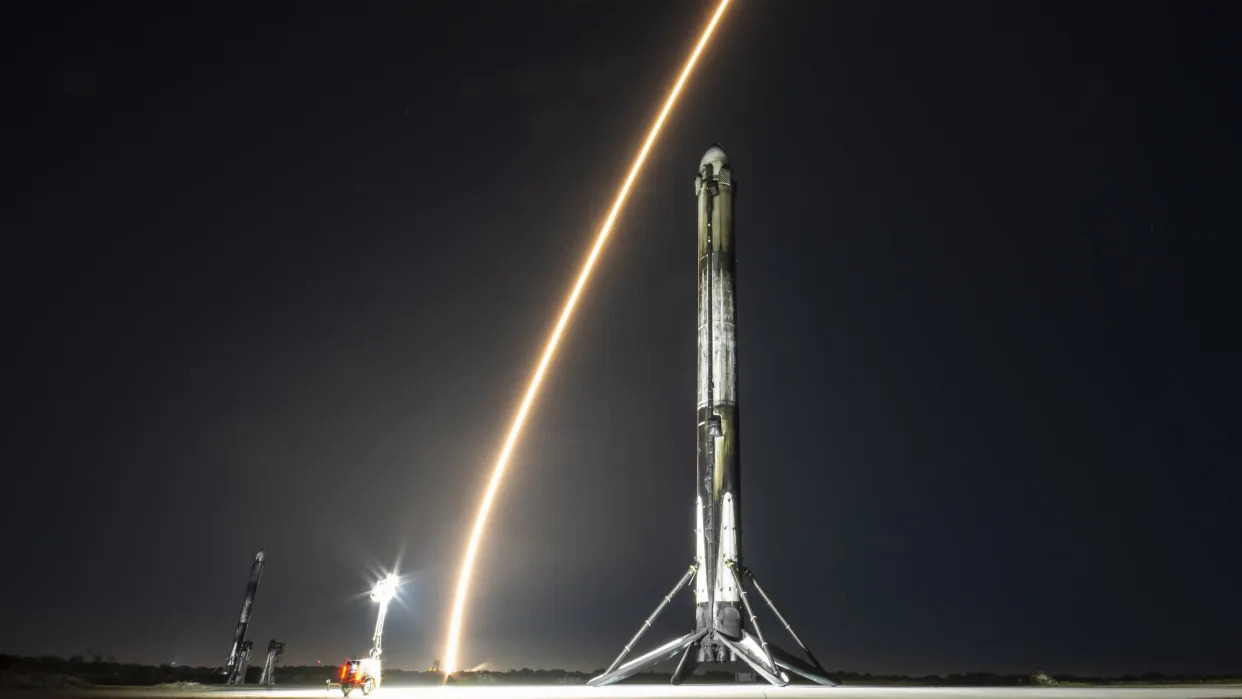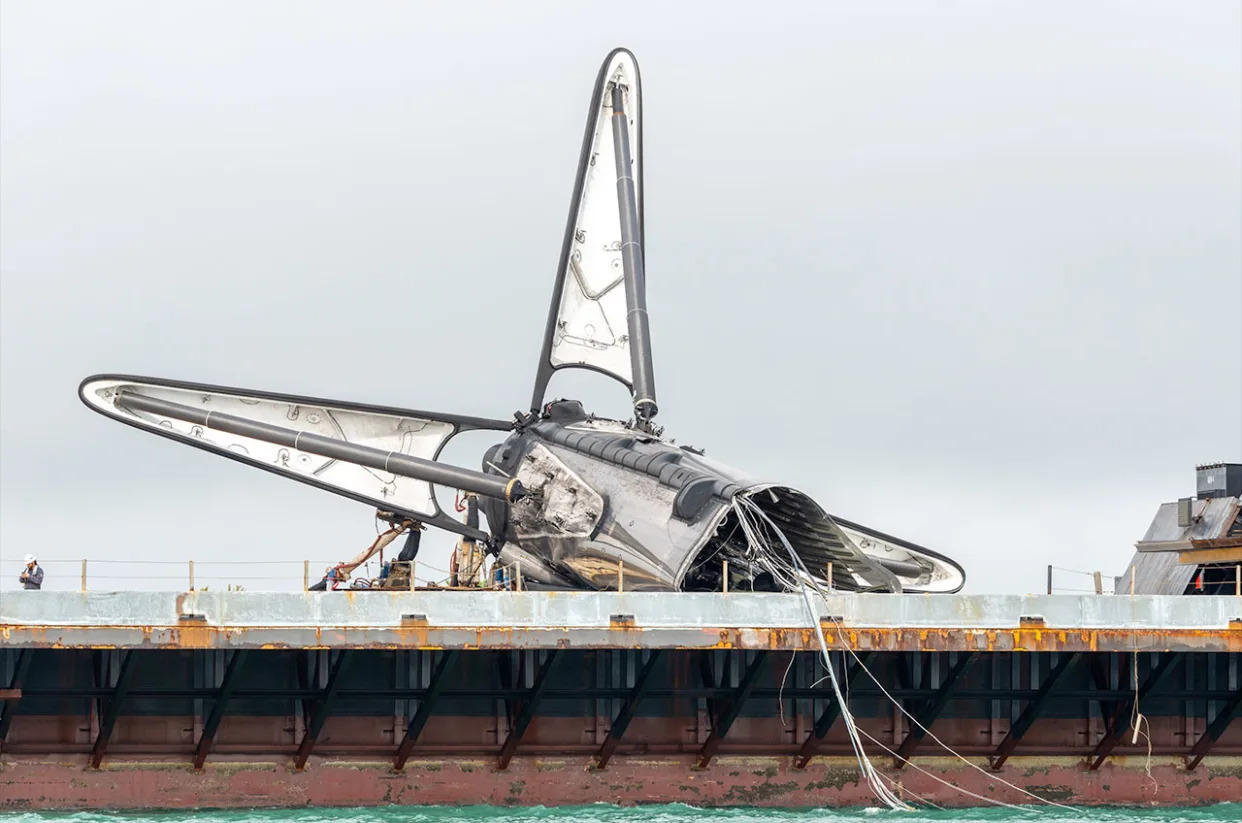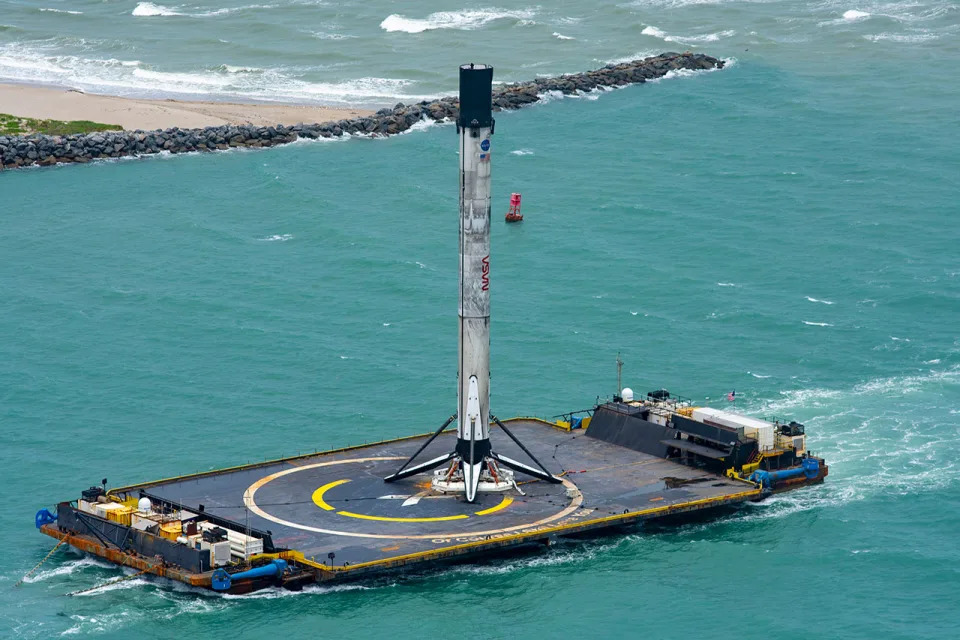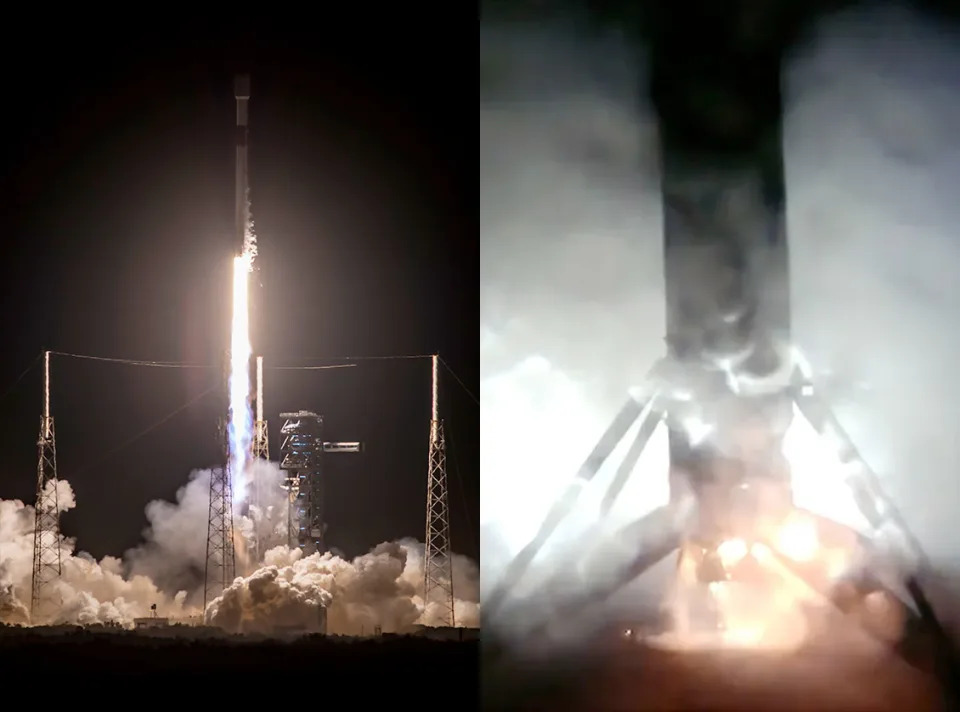SpaceX successfully launches two rockets hours apart
Mark Moran
Thu, December 28, 2023

The SpaceX Falcon 9 rocket is raised to a vertical position as it is prepared to launch the Galaxy 37 communications satellite for Intelsat from Launch Complex 40 at the Cape Canaveral Space Force Station, Florida on Wednesday, August 2, 2023. Photo by Joe Marino/UPI
Dec. 28 (UPI) -- Less than three hours after the launch of a mysterious space plane atop a Falcon Heavy rocket, SpaceX launched a second launch Thursday night, at 11:01 p.m. EST, deploying its latest batch of Starlink internet satellites into low-Earth orbit.
The secretive space plane went into orbit earlier in the evening via a Falcon Heavy rocket as part of a payload that also includes scores of living plant seeds that are part of NASA's mission to understand the effects of long-duration spaceflight on humans and how those plants grow in space. It was the shortest time between launches at Cape Canaveral since 1966.
Thursday night's launch, in which the Falcon 9 rocket rode a blazing column of fire, which was broadcast live, leaves SpaceX just shy of 100 launches in 2023, at 98. The company has added substantially to the number of broadband satellites it has put in orbit and created competition in the Internet service provider market. SpaceX's final mission for 2023, number 99, is scheduled to launch Saturday from Vandenberg Space Force Base in California.
That's an increase of nearly 70% over last year's total, when SpaceX carried out 61 launches, and that was double what it achieved in 2021. Most of the launches are of Falcon 9 rockets, but SpaceX has also launched a small handful of Falcon Heavy rockets, such as the one that carried the space plane into orbit Thursday night.
As of last month, the Starlink internet satellite constellation consisted of more than 5,200 broadband-providing small satellites in low-Earth orbit. The company has said it intends to deploy as many as 12,000 satellites for Starlink, and is seeking approval to launch as many as 42,000 in the years to come. Critics of the high volume technology have blamed the plethora of satellites for creating space junk, light pollution and low Earth hazards for other spacecraft.
For SpaceX, which has become well known for reusing its spacecraft infrastructure, Thursday night's launch was the 12th flight for this first-stage booster, which returns to Earth and lands aboard a vessel in the water after blasting the rocket into orbit. In this case, the booster landed on a drone ship 'A Shortfall of Gravitas' about eight and a half minutes into the flight.
SpaceX Falcon 9 rocket launches 23 Starlink satellites into orbit in final flight of 2023
Robert Lea
Thu, December 28, 2023

A rocket launching in the blackness.
SpaceX launched its latest batch of satellites on Thursday night (Dec. 28) from Cape Canaveral Space Force Station in Florida.
The 23 Starlink broadband internet spacecraft were carried to low Earth orbit atop a Falcon 9 rocket at 11:01 p.m. EST (0401 GMT Friday, Dec. 29).
This wasn't the only SpaceX mission today, however. The company also launched a Falcon Heavy rocket carrying the secretive X-37B spaceplane earlier in the evening.
Related: SpaceX Falcon Heavy rocket launches mysterious X-37B space plane for US Space Force after delays

A rocket booster sits on a droneship after landing from space
The Starlink launch (known as 6-36) was the company's 98th and final planned launch for this year.
The 98 SpaceX launches in 2023 are include 91 Falcon 9 blast-offs, five Falcon Heavy launches, and two lift-offs for the company's Starship launch system. SpaceX carried out 61 launches in 2022 — 60 for Falcon 9 rockets and just one Falcon Heavy launch — and achieved 31 launches in 2021 and 26 in 2020, all of which were Falcon 9 rockets.
SpaceX will just miss out on closing out 2023 with 100 launches, with the next mission for the company planned for Tuesday (Jan. 2). SpaceX's first launch of 2024 will see a further 21 Starlink spacecraft carried to low Earth orbit by a Falcon 9 rocket, which will lift off from Vandenberg Space Force Base in California.
Related
— SpaceX’s Starlink internet satellites ‘leak’ so much radiation that it’s hurting radio astronomy, scientists say
— Will Artemis 2 launch to the moon in 2024? NASA has a lot of work ahead
—SpaceX Falcon Heavy seen from space waiting on launch pad (photos)
The Dec. 28 Starlink launch was the 12th flight for this first-stage booster, according to SpaceX, which has also carried CRS-24, Eutelsat HOTBIRD 13F, OneWeb 1, SES-18 and SES-19 cargo to space, as well as conducting seven previous Starlink missions.
As of November 2023, the Starlink mega constellation consisted of over 5,200 operational broadband internet-providing small satellites in low-Earth orbit. SpaceX intends to deploy as many as 12,000 satellites for Starlink, with the company hoping they will be allowed to expand this to as many as 42,000 units.
History-making SpaceX Falcon 9 booster mostly destroyed in post-flight topple
Robert Z. Pearlman
Wed, December 27, 2023

The remains of SpaceX's first Falcon booster to fly astronauts into orbit are seen atop the droneship "Just Read the Instructions" after a mishap following the stage's record 19th launch.
The first U.S. commercial rocket to launch astronauts into orbit has met its end after being destroyed during its latest post-flight recovery.
Referred to by SpaceX by its serial number, B1058, the Falcon 9 first stage was being transported back to shore after its record-setting 19th flight when "the booster tipped over "due to high winds and waves," the company reported on X, the social network previously known as Twitter, on Sunday (Dec. 25).
Two days earlier, the stage had helped launch 23 of SpaceX's Starlink broadband satellites before successfully touching down on the company's droneship "Just Read the Instructions," which was stationed in the Atlantic Ocean, off the coast of Florida.
Photos shared online of the returning ship revealed that only the lower segment of B1058 remained, with three of its four landing legs still deployed and all nine of its Merlin engines still intact.
"We are planning to salvage the engines and do life leader inspections on the remaining hardware. There is still quite a bit of value in this booster. We will not let it go to waste," wrote Jon Edwards, SpaceX's vice president of Falcon launch vehicles, on X on Tuesday (Dec. 26).
Related: SpaceX: Facts about Elon Musk's private spaceflight company

a booster sitting on top of a drone ship
Seen after landing from its first flight in 2020, B1058 was the only Falcon 9 first stage to be adorned with the NASA "worm."

SpaceX's Falcon 9 first stage B1058 is seen launching (at left) and landing on Dec. 23, 2023, completing its 19th re-flight. (Image credit: SpaceX)
Other Falcon 9 first stages might have survived the rough sea conditions given improvements made to their landing legs.
"We came up with self leveling legs that immediately equalize leg loads on landing after experiencing a severe tippy booster two years ago on Christmas," wrote Kiko Dontchev, SpaceX's vice president of launch, on X. "The fleet is mostly outfitted, but 1058, given its age, was not. It met its fate when it hit intense wind and waves resulting in failure of a partially secured OG ["octograbber" hold-down clamp] less than 100 miles [160 kilometers] from home."
"One thing is for sure we will make lemonade out of lemons and learn as much as possible from historic 1058 on our path to aircraft like operations," he wrote.
With the loss of 1058, SpaceX is believed to have 16 flight-proven, active Falcon 9 first stages still remaining and three pending their first use.

SpaceX plans to salvage the nine Merlin engines from what remains of its first Falcon 9 booster to fly 19 times, including the company's first flight with astronauts aboard. Seen here, the wreckage atop the droneship
Fans of the company reacted to the news of 1058's destruction with regrets that it had not made it into the Smithsonian or another museum to be preserved.
To date, SpaceX has retired four of its earlier-flown Falcon 9 stages for public display. B1019, the first to return to its launch site for a successful landing, today stands outside the company's headquarters in Hawthorne, California. B1035, which launched two Dragon cargo missions to the International Space Station, is now exhibited on its side at Space Center Houston in Texas.
B1023, which helped launch Elon Musk's Tesla Roadster into space as a side booster on the first Falcon Heavy rocket launch, is now a part of "Gateway: The Deep Space Launch Complex" attraction at the Kennedy Space Center Visitor Complex in Florida. And B1021, the first booster to be re-flown and the first to land on a droneship, was just recently installed outside Dish Network's headquarters in Littleton, Colorado.
A SpaceX rocket booster was ruined after toppling over in rough waters
Haley Tenore
Wed, December 27, 2023
A SpaceX Falcon 9 booster was ruined during transit back to port over the weekend.
The booster had launched over 860 satellites and two people into orbit, according to SpaceX.
SpaceX is down a rocket booster after a Christmas snafu.
One of its Falcon 9 boosters, B1058, tipped over after landing on its drone ship while being transported back to Cape Canaveral, Florida, according to SpaceX. The booster, an older model that lacked some of the auto-stabilization leg features, fell over due to rough rough waters and turbulent winds, the company said.
Wind and turbulent waters can make landing more difficult, SpaceX's VP of launch, Kiko Dontchev, wrote on X.
"Tippy boosters occur when you get a certain set of landing conditions that lead to the legs having uneven loading," Dontchev wrote. "Heavy wind or sea state then cause the booster to teeter and slide which can lead to even worse leg loading."
"We will make lemonade out of lemons and learn as much as possible," Dontchev added.
Newer versions of Falcon boosters are less likely to tip over thanks to better landing legs designed to better self-level themselves.
This particular Falcon 9 booster finished its 19th and final mission on December 23. It transported over 860 satellites into space over the past three and a half years, the space company said.
SpaceX VP for Falcon Launch Vehicles Jon Edwards told the Orlando Sentinel that SpaceX won't let the rest of the booster "go to waste." He said the company plans to recover the engine and inspect the rest of the booster's remaining hardware.
Despite B1058's bumpy landing that left it unusable, SpaceX isn't slowing down anytime soon.
On Thursday evening, a launch window is scheduled to open for SpaceX's Falcon Heavy ship carrying the Space Force's mysterious X-37B space plane to orbit, Florida Today reported.
A launch window for the Starlink 6-36 mission is also expected to open between late Thursday night and early Friday morning, according to Florida Today. If conditions permit, a Falcon 9 will launch from Complex 40 at the Cape Canaveral Space Force Station.
Robert Z. Pearlman
Wed, December 27, 2023

The remains of SpaceX's first Falcon booster to fly astronauts into orbit are seen atop the droneship "Just Read the Instructions" after a mishap following the stage's record 19th launch.
The first U.S. commercial rocket to launch astronauts into orbit has met its end after being destroyed during its latest post-flight recovery.
Referred to by SpaceX by its serial number, B1058, the Falcon 9 first stage was being transported back to shore after its record-setting 19th flight when "the booster tipped over "due to high winds and waves," the company reported on X, the social network previously known as Twitter, on Sunday (Dec. 25).
Two days earlier, the stage had helped launch 23 of SpaceX's Starlink broadband satellites before successfully touching down on the company's droneship "Just Read the Instructions," which was stationed in the Atlantic Ocean, off the coast of Florida.
Photos shared online of the returning ship revealed that only the lower segment of B1058 remained, with three of its four landing legs still deployed and all nine of its Merlin engines still intact.
"We are planning to salvage the engines and do life leader inspections on the remaining hardware. There is still quite a bit of value in this booster. We will not let it go to waste," wrote Jon Edwards, SpaceX's vice president of Falcon launch vehicles, on X on Tuesday (Dec. 26).
Related: SpaceX: Facts about Elon Musk's private spaceflight company

a booster sitting on top of a drone ship
Seen after landing from its first flight in 2020, B1058 was the only Falcon 9 first stage to be adorned with the NASA "worm."
(Image credit: SpaceX)
Lost with the upper segment of B1058 was a unique, tell-tale marking that it had been used to launch the first astronauts for NASA. The booster was the only stage in SpaceX's fleet to be adorned with the space agency's "worm" logotype.
On May 30, 2020, B1058 lifted off for the first time on SpaceX's Demo-2 (DM-2) mission carrying NASA astronauts Bob Behnken and Doug Hurley aboard the company's Crew Dragon capsule "Endeavour." The two-month long mission to the International Space Station was the first to launch American astronauts from the United States since the end of NASA's space shuttle program in 2011.
Since that flight, B1058 was used in the launch of SpaceX's 21st cargo delivery to the space station (CRS-21), a dedicated satellite launch for South Korea (ANASIS-II), two shared ride satellite launches (Transporter-1 and Transporter-3) and 14 Starlink missions. The stage, like the other "Block 5" boosters in SpaceX's fleet, had been certified for 20 launches.
"This one reusable rocket booster alone launched to orbit two astronauts and more than 860 satellites, totaling 260+ metric tons, in about 3.5 years," SpaceX posted on X.
Lost with the upper segment of B1058 was a unique, tell-tale marking that it had been used to launch the first astronauts for NASA. The booster was the only stage in SpaceX's fleet to be adorned with the space agency's "worm" logotype.
On May 30, 2020, B1058 lifted off for the first time on SpaceX's Demo-2 (DM-2) mission carrying NASA astronauts Bob Behnken and Doug Hurley aboard the company's Crew Dragon capsule "Endeavour." The two-month long mission to the International Space Station was the first to launch American astronauts from the United States since the end of NASA's space shuttle program in 2011.
Since that flight, B1058 was used in the launch of SpaceX's 21st cargo delivery to the space station (CRS-21), a dedicated satellite launch for South Korea (ANASIS-II), two shared ride satellite launches (Transporter-1 and Transporter-3) and 14 Starlink missions. The stage, like the other "Block 5" boosters in SpaceX's fleet, had been certified for 20 launches.
"This one reusable rocket booster alone launched to orbit two astronauts and more than 860 satellites, totaling 260+ metric tons, in about 3.5 years," SpaceX posted on X.

SpaceX's Falcon 9 first stage B1058 is seen launching (at left) and landing on Dec. 23, 2023, completing its 19th re-flight. (Image credit: SpaceX)
Other Falcon 9 first stages might have survived the rough sea conditions given improvements made to their landing legs.
"We came up with self leveling legs that immediately equalize leg loads on landing after experiencing a severe tippy booster two years ago on Christmas," wrote Kiko Dontchev, SpaceX's vice president of launch, on X. "The fleet is mostly outfitted, but 1058, given its age, was not. It met its fate when it hit intense wind and waves resulting in failure of a partially secured OG ["octograbber" hold-down clamp] less than 100 miles [160 kilometers] from home."
"One thing is for sure we will make lemonade out of lemons and learn as much as possible from historic 1058 on our path to aircraft like operations," he wrote.
With the loss of 1058, SpaceX is believed to have 16 flight-proven, active Falcon 9 first stages still remaining and three pending their first use.

SpaceX plans to salvage the nine Merlin engines from what remains of its first Falcon 9 booster to fly 19 times, including the company's first flight with astronauts aboard. Seen here, the wreckage atop the droneship
Fans of the company reacted to the news of 1058's destruction with regrets that it had not made it into the Smithsonian or another museum to be preserved.
To date, SpaceX has retired four of its earlier-flown Falcon 9 stages for public display. B1019, the first to return to its launch site for a successful landing, today stands outside the company's headquarters in Hawthorne, California. B1035, which launched two Dragon cargo missions to the International Space Station, is now exhibited on its side at Space Center Houston in Texas.
B1023, which helped launch Elon Musk's Tesla Roadster into space as a side booster on the first Falcon Heavy rocket launch, is now a part of "Gateway: The Deep Space Launch Complex" attraction at the Kennedy Space Center Visitor Complex in Florida. And B1021, the first booster to be re-flown and the first to land on a droneship, was just recently installed outside Dish Network's headquarters in Littleton, Colorado.
A SpaceX rocket booster was ruined after toppling over in rough waters
Haley Tenore
Wed, December 27, 2023
A SpaceX Falcon 9 booster was ruined during transit back to port over the weekend.
The booster had launched over 860 satellites and two people into orbit, according to SpaceX.
SpaceX is down a rocket booster after a Christmas snafu.
One of its Falcon 9 boosters, B1058, tipped over after landing on its drone ship while being transported back to Cape Canaveral, Florida, according to SpaceX. The booster, an older model that lacked some of the auto-stabilization leg features, fell over due to rough rough waters and turbulent winds, the company said.
Wind and turbulent waters can make landing more difficult, SpaceX's VP of launch, Kiko Dontchev, wrote on X.
"Tippy boosters occur when you get a certain set of landing conditions that lead to the legs having uneven loading," Dontchev wrote. "Heavy wind or sea state then cause the booster to teeter and slide which can lead to even worse leg loading."
"We will make lemonade out of lemons and learn as much as possible," Dontchev added.
Newer versions of Falcon boosters are less likely to tip over thanks to better landing legs designed to better self-level themselves.
This particular Falcon 9 booster finished its 19th and final mission on December 23. It transported over 860 satellites into space over the past three and a half years, the space company said.
It also transported astronauts Bob Behnken and Doug Hurley to the International Space Station in 2020. This was the first manned American flight into space since the end of the space shuttle program in 2011 and SpaceX's first manned mission.
SpaceX VP for Falcon Launch Vehicles Jon Edwards told the Orlando Sentinel that SpaceX won't let the rest of the booster "go to waste." He said the company plans to recover the engine and inspect the rest of the booster's remaining hardware.
Despite B1058's bumpy landing that left it unusable, SpaceX isn't slowing down anytime soon.
On Thursday evening, a launch window is scheduled to open for SpaceX's Falcon Heavy ship carrying the Space Force's mysterious X-37B space plane to orbit, Florida Today reported.
A launch window for the Starlink 6-36 mission is also expected to open between late Thursday night and early Friday morning, according to Florida Today. If conditions permit, a Falcon 9 will launch from Complex 40 at the Cape Canaveral Space Force Station.
No comments:
Post a Comment